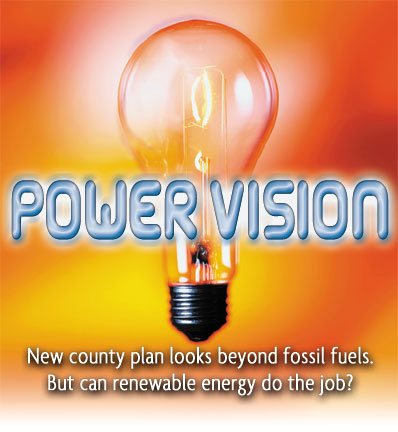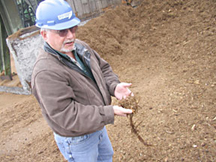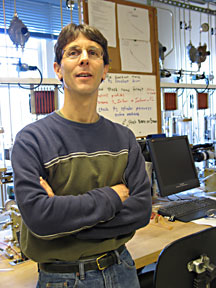|
COVER
STORY | IN THE NEWS | OPINION November 3, 2005
by JIM HIGHT IF YOU HAVEN'T SEEN THE HEADLINES YET, YOUR UTILITY BILL will soon deliver the bad news: Natural gas prices are rising 70 percent or more this fall and winter due to supply disruptions on the Gulf Coast. And since natural gas is the main fuel used to generate electricity in California, the rising gas prices will also drive up the cost of electricity over the winter. Experts disagree about what will happen with natural gas prices after the hurricane damage is repaired, but there's no disputing the fact that natural gas, like petroleum, is a fossil fuel that won't last forever. So, how much longer can we -- or should we -- rely on natural gas for electricity generation? According to Pacific Gas & Electric Company, gas-fired generation will continue to be the backbone of the power system in Humboldt County for the foreseeable future. The utility will soon replace its 50-year-old King Salmon power plant with another gas-burner, albeit a more efficient one that generates more power with less gas. But a coalition of local governments has just released an energy plan that articulates a very different vision for the future of local electricity generation. Approved in October by the Redwood Coast Energy Authority (RCEA), the Energy Element focuses on more than electricity generation. It recommends transportation strategies to save gasoline, new building standards to conserve energy used in heating and lighting, a sharp increase in the use of solar hot water heaters, and other approaches. Many of the ideas could be implemented by local governments through their land-use and zoning powers, and RCEA will promote the plan to local governments represented on its board: The County of Humboldt (where the Energy Element is expected to become a part of the new general plan) and the cities of Arcata, Blue Lake, Eureka, Ferndale, Fortuna, Rio Dell and Trinidad. Funding to develop the plan came from PG&E (using money from a tax on our utility bills), North Coast Unified Air Quality Management District and the U.S. Department of Energy. But the Energy Element's most far-reaching recommendations call for a fundamental shift away from our current privately owned, state-regulated, fossil fuel-dependent electric power system. It envisions rapid development of renewable energy and aggressive conservation measures leading to energy independence and energy self-sufficiency in Humboldt County within 20 years. The plan also calls for greater local control over electricity production and pricing, and the exporting of surplus electricity to bring revenues into the county. The RCEA's plan is light on specifics of how such a transformation will be engineered and funded. But despite its lack of details on these matters, the Energy Element mounts a formidable challenge to the "business-as-usual" perspective toward our energy future. Unfortunately, it also almost entirely misses and issue that will be the key obstacle to incorporating more renewable power in the local electricity grid. No wind, no coffeeWind, solar and other renewable power technologies are producing a growing proportion of the electricity consumed worldwide. But as renewable power grows, so does the challenge of integrating it into a power grid. The demand for electricity in any community changes constantly, usually cycling between twice-a-day peaks and troughs. The graph on page 11 shows how electricity usage moved up and down over 24 hours in Humboldt County one day last December.
At 4 a.m., the demand, or "load," was at it lowest point. For the next three and a half hours, county residents awoke and turned on lights, heaters, TVs and coffee makers; stores opened, industries cranked up and schools began their day; and the load climbed steadily until it reached a morning peak just before 8 a.m. Later in the day, when people arrived home from work and school and turned on their entertainment centers, washers, dryers, heaters and computers, the load rose to an even higher peak around 7 p.m. As the graph for one day this past July shows, our summer usage also peaks twice, but on a different schedule. There was a later morning peak, perhaps because most schools were out, and a lower evening peak, probably due to less lighting and electric heating Because of the nature of electric power, generation must match the load exactly, moment by moment. If the load exceeds the generation, or vice versa, the electrical frequency gets out of whack and really nasty and expensive damage ensues. To prevent this, utilities have automatic sensors that shut down parts of the grid when generation doesn't match load. When rotating outages plagued California in 2000 and 2001, it was because peak loads could not be met with the available generation resources. Matching the load curve is something that gas-fired power plants are good at. Human operators and automatic controls throttle them up and down constantly to meet the ever-changing demand. But wind, solar and most other renewable sources are not good at this. Solar panels only produce significant electricity when the sun is shining, and wind turbines only generate when the wind is blowing at a good clip. So even if Humboldt County became the renewable energy capital of the world, we still couldn't rely on wind and solar power to run a coffee-maker at 7:15 every morning. Energy experts and utility managers worldwide are increasingly focusing on the challenge of how to integrate intermittent renewable power sources like wind and solar into electricity grids. At the 4th World Wind Energy Conference taking place this week in Melbourne, Australia, grid integration is a major point of discussion, with 16 speakers scheduled to address it. At least the topic is mentioned in the Technical Report accompanying the Energy Element. "Not only does the county need to meet its annual energy needs, but it must also meet the peak demands that occur at any given time," states the report, which was written by engineers from Humboldt State University's Schatz Energy Research Center. Renewable resources such as solar and wind are not "dispatchable," or available to meet demand reliably, notes the report. Electricity from wind and solar could be more reliably available if electricity could be stored in large amounts. But while batteries hooked to solar panels can store enough electricity for household use, utility-scale storage systems don't exist. Schatz researchers have pioneered the use of hydrogen as a storage medium for solar-generated electricity, but they say that hydrogen technology is nowhere near ready to use on the grid. "It's not a near-term thing that will happen cost effectively," says Jim Zoellick, principal author of the Technical Report. Nonetheless, there is great potential to increases the contribution of renewable power locally, and the Technical Report analyzed many renewable technologies. These are among the most promising.
Tree power
Left: Fairhaven
power plant general manager, Bob Marino.
With large forest-thinning projects underway on federal lands to reduce fire danger, the Forest Service and local tribes are studying the prospects for using biomass generators to burn the logged trees to produce power. But due to the cost of transporting and handling small-diameter logs, these new biomass projects would probably only be cost-effective with subsidies that are not currently available, according to the Technical Report. The report analyzes North Coast lumber data and finds that timber companies are growing trees twice as fast as they're cutting them. So the local lumber supply is sustainable, at least in production terms, which bodes well for the future of wood-fired generation. Biomass power is not intermittent like wind and solar. Except when the units are down for maintenance or repairs, they run 24/7. But they produce a steady quantity of power, with little capacity to vary the amount. So unlike gas-fired generation, this "baseload" power cannot be ramped up to meet peak demands.
Solar needs subsidiesFor decades, backcountry residents of the North Coast have used solar photovoltaic (PV) panels and batteries to enjoy electricity while living off the power grid. But more recently, increasing numbers of PG&E users have become "customer-generators," installing PV systems and feeding electricity to the utility in exchange for credit on their bills. "On a per-capita basis Humboldt County has installed grid-connected PV systems 3.5 times faster than the state as a whole," states the Technical Report. In spite of our oft-gray skies, "solar works here [and] people are interested in installing it." Currently, there are nearly 200 grid-connected solar power generators in Humboldt County, according to the report and an interview with Roger, the region's leading solar installer. (He uses only one name.) On a sunny day, they meet as much as 0.3 percent of our electricity load. But the funds that refund part of the cost of installing PV in California are declining. A recent proposal to re-energize the subsidy program, for a campaign to install 1,000,000 solar rooftops, died in the legislature in September. If the subsidies disappear and no new financial incentives are offered, the pace of PV installation in Humboldt County could slow. But with adequate financing, PV could grow to supply 5 to 10 percent of our peak demand (when the sun is shining) by 2025, according to the report.
Fish-friendly hydropowerWhile tar and feathers would probably be applied to anyone who tried to build a new dam in salmon-loving Humboldt County, small "run-of-river" hydropower plants could be developed with less impact on fisheries. These systems divert only a portion of a river or stream's flow, and they don't block fish passage. A handful of small run-of-river hydro plants have been built here, and two are currently producing very small amounts of power, according to the Technical Report. An analysis done for the county 20 years ago estimated that as much as 60 megawatts of additional power -- about 35 percent of today's peak demand -- could be developed locally. An expert consulted for the Technical Report found this estimate unrealistic, but with proper financing and favorable wholesale electricity rates, run-of-river hydropower could meet close to 20 percent of local peak demand, according to the report. But regulatory and permitting costs would be extremely high for hydropower developers. A partnership that proposed a run-of-river hydroelectric plant near Willow Creek spent $75,000 on studies, "only to find out that regulators wanted another round of studies" that would cost about $200,000 before the project could proceed, states the Technical Report.
Waves and wattsIf the energy in the waves that pound our coast could be tapped, it could power one-fourth of California. Just the "primary sites" with favorable depths and wave conditions could yield 3900 megawatts of generation capacity -- 25 times the local electricity demand at peak hours, according to a California Energy Commission study. "If" is the important word. Wave-energy converters (WECs) that generate electricity from the motion of the ocean have been around for decades. But the early devices fell apart in storms. Since then, a new crop of WECs has been engineered to endure harsh ocean conditions. Two different companies are proposing to test WECs off our coast. DG Energy Solutions (San Diego), which bought the Fairhaven biomass plant from Eel River Sawmills, is proposing to install a field of 40 WECs manufactured by Ocean Power Technologies off the Samoa Peninsula. And Independent Natural Resources Inc. (Eden Prairie, Minn.) is proposing to test its SEADOG buoys off of Table Bluff. While the OPT WEC would generate power in the ocean, the SEADOG would pump seawater to an onshore reservoir and hydropower generation system. As the Technical Report notes, wave power is still in early development and it's too early to tell what its contribution to our electric grid could be.
Is it in the wind?Wind power is by far the most robust and well-developed form of renewable energy that provides what's known as "central generation" -- producing concentrated power in one location and distributing it across transmission lines. California is already stocked with thousands of wind turbines that provide about 1.5 percent of the state's electricity. But with existing technology, wind energy plants can only be developed in areas with very high and consistent winds. On the North Coast, the prime wind site is Bear River Ridge, between Ferndale and Petrolia. According to the Technical Report, Shell Wind is currently exploring the feasibility of developing a wind farm there. In addition, DG Energy is testing wind speeds on its Samoa Peninsula property, with an eye toward building a wind-power facility with 10 turbines. In DG's overall conceptual plan, the wind power would be combined with new wave power and the existing biomass plant. "If we get this done, it will be the only tri-renewable energy facility in North America," says General Manager Bob Marino. Both proposals would require extensive and costly environmental reviews by a host of state and federal agencies. The bird fatalities associated with older, fast-spinning wind turbines might not be a barrier because the modern turbines are larger and slower-moving. But scenic values certainly would be. The Samoa peninsula is visible from all around Humboldt Bay, and Bear River Ridge is very prominent from many vantage points. The ridge-top site would also require a new high-capacity transmission line to connect to the grid. And according to the Technical Report, a proposed windpower plant on Cooksie Ridge near Petrolia was shot down earlier over "aesthetic objections." But wind may be Humboldt County's best shot at achieving a significant supply of renewable energy within the next decade. The Technical Report points out that the intermittence problem could be managed by balancing wind power with conventional generation, like the new gas-fired plant PG&E expects to have online at its Humboldt Bay site. The local control optionWhile PG&E is obligated
by law to increase its use of renewable power over the next decade,
it gets to do so in its own fashion and throughout its vast service
territory, which stretches as far south as Santa Barbara County.
For a variety of financial and logistical reasons, Humboldt County
is probably not the most advantageous place for the utility to
purchase large amounts of renewably generated electricity. Right: James Zoellick, research engineer, at a fuel cell test station at the Schatz Energy Research Center on the Humboldt State campus. Photo by Bob Doran. One strategy highlighted by the RCEA to make renewable energy a higher priority is to form what's known as a Community Choice Aggregation agency. In reaction to the 2000-2001 energy crisis, California legislators created the CCA option for local governments that wanted to buy and sell electricity within their jurisdictions. San Francisco and dozens of other communities around the state are pursuing or exploring the idea of becoming Community Choice Aggregators. In most cases, their motivation is to invest aggressively in developing and purchasing renewably generated electricity. If a CCA were formed here, it could, at least in theory, invest in local renewable energy at a faster and more aggressive pace than PG&E would do. Establishing a CCA would be a complex, expensive and risky project, and the energy authority board has only begun to explore the idea. At its recent meeting, it voted to bring managers and staff of the eight local governments into the discussion. And early next year, a forum may be organized with a presentation from Navigant Consulting, the company that has helped other local governments in California research their CCA options. Forming a CCA "would have large potential implications for Humboldt County," David Boyd, director of the energy authority, wrote in an e-mail. "While it is moving forward around the state, it has not yet been fully implemented anywhere to my knowledge. It's worth keeping a very close eye on this issue, but we probably don't have the local resources to be `on the bleeding edge.'" But with natural gas prices cutting so deeply this winter, the need to chart a new course toward a sustainable energy future is becoming more and more obvious. The Energy Element gives citizens a good place to start.
At PG&E's Humboldt Bay Power Plant near King Salmon [above], Roy Willis, the plant manager, strides up catwalks and through steel doors until he reaches a gray boiler as big as a house. "This is where we make steam," he shouts over the roar of gas burners. The steam is piped to the blades of a turbine, which spins an electrical generator, which at this moment is cranking out more than 20 million watts, according to a display on the wall. But some steam is also being stored for a rainy day - literally. In a nearby corner, Willis points to a black vessel that looks like an enormous propane tank. He explains that this drum, and its twin on the plant's other generating unit, is kept full of steam at all times. Because of Humboldt County's tenuous connections to the Western power grid, these pressure cookers of stored energy might be needed at any moment. While most California communities have multiple linkages to the high-voltage transmission lines crisscrossing the state, Humboldt County's connections consist of two sets of low-capacity lines strung across wildlands to the south and east. Upgrading these transmission lines is not a viable option because of the huge costs - up to $270 million, according to one estimate. And putting hundreds of new steel towers through federal forest lands would provoke an environmental battle to rival the conflict over Calpine's proposed liquefied natural gas terminal. So for now and for the foreseeable future, Humboldt County can only import a limited amount of power from the outside. And when winter storms knock out the power lines, we get none at all. "We're like our own utility up here," says Willis. To cope, PG&E has equipped the Humboldt Bay plant with special reliability features. The two steam drums, for instance. When transmission lines get disrupted - something that happens as often as twice a week in a rough winter - sensors instantly release steam from the drums to push the generators up to their full output, making up the lost voltage before most electricity users notice any interruption. In addition, if natural gas supplies, 90 percent of which come in through a single pipeline, run short, the gas-fired boilers can switch quickly to burning fuel oil. And two mobile jet-fueled generators are ready to be fired up if extra power is needed. Things can still get dicey. In worst-case scenarios, a winter cold snap is followed by an intense storm that knocks out transmission lines and highways. Due to the cold temperatures, homes, schools, stores, plants and offices need extra gas for heating, so the power plant switches to fuel oil. The jet turbines come on to meet peak electricity demands. But if this lasts more than a day or so, PG&E managers start to worry about their fuel supplies. With the roads closed, trucks can't deliver more oil or jet fuel. "We've been on the ragged edge in those types of situations," says Brian Robb, who manages Humboldt Substation, the control center for the local electric power system. "Sometimes we have to go into rotating outages." "This area has issues with available gas for generation and winter peaking," says Robb. Given this situation, you'd think that PG&E managers would be eager for as much additional power as they could get - including renewable power. But they're not, because solar and wind power are intermittent and cannot be relied upon to meet electricity demand when it's needed. "Wind power is great," says Willis, pointing out that PG&E buys large amounts of it from the wind farm at Altamont, east of the Bay Area. But on PG&E's main California power system, the intermittence of wind can be managed because there are so many reliable generation sources in the mix. Out here on the North Coast, Willis says, reliability is more critical. "The problem with wind is that it's often not there when you need it." "You've got to push the envelope, though," says Willis, noting that he recently had a solar photovoltaic system installed on his home. PG&E is in the process of replacing the Humboldt Bay Power Plant, which turns 50 next year. "We've upgraded and invested a lot, but we're getting to the point where we face some major issues," said Willis. A couple years ago, a crack in one of the two main turbines was nearly an "end-of-life event," according to Willis. PG&E could contract with an independent power producer to build and operate a new gas-fired plant in the same location, or build and operate its own plant. "Hopefully, we'll own it," says Willis. Whether owned by PG&E or another company, a modern plant will be more efficient - generating more power with less gas. That will help a bit when storms and cold temperatures stretch the local gas supply. But it won't change the fact that electricity in Humboldt County is not as reliable as in most of the state. Robb, a 30-year veteran of PG&E operations here, thinks the next rough winter will bring a shock to recent arrivals. "We're going to continue to experience more outages and difficulties in restoring power relative to where people are coming from," he says. "The retirees coming up here are coming from areas where they're used to more reliability." Frequent Journal contributor Jim Hight has covered energy issues for the California Energy Circuit and Environmental Business Journal. E-mail him at jbhight@sbcglobal.net. COVER
STORY | IN THE NEWS | OPINION Comments? Write a letter! © Copyright 2005, North Coast Journal, Inc. |




 Humboldt
County is already using far more renewable power per capita than
most of California. This is because we get about 30 percent of
our electricity from the first renewable energy source ever used
by humans: wood.
Humboldt
County is already using far more renewable power per capita than
most of California. This is because we get about 30 percent of
our electricity from the first renewable energy source ever used
by humans: wood. In other
regions, agricultural wastes like rice straw are burned to generate
power, which is why this form of generation is called biomass
power. Here, two local biomass power producers -- Fairhaven Power
and Pacific Lumber Co. -- generate electricity by burning the
bark and other wood waste from area sawmills. A third plant,
Ultrapower in Blue Lake, has been off-line since 1999, but could
be restarted.
In other
regions, agricultural wastes like rice straw are burned to generate
power, which is why this form of generation is called biomass
power. Here, two local biomass power producers -- Fairhaven Power
and Pacific Lumber Co. -- generate electricity by burning the
bark and other wood waste from area sawmills. A third plant,
Ultrapower in Blue Lake, has been off-line since 1999, but could
be restarted.




